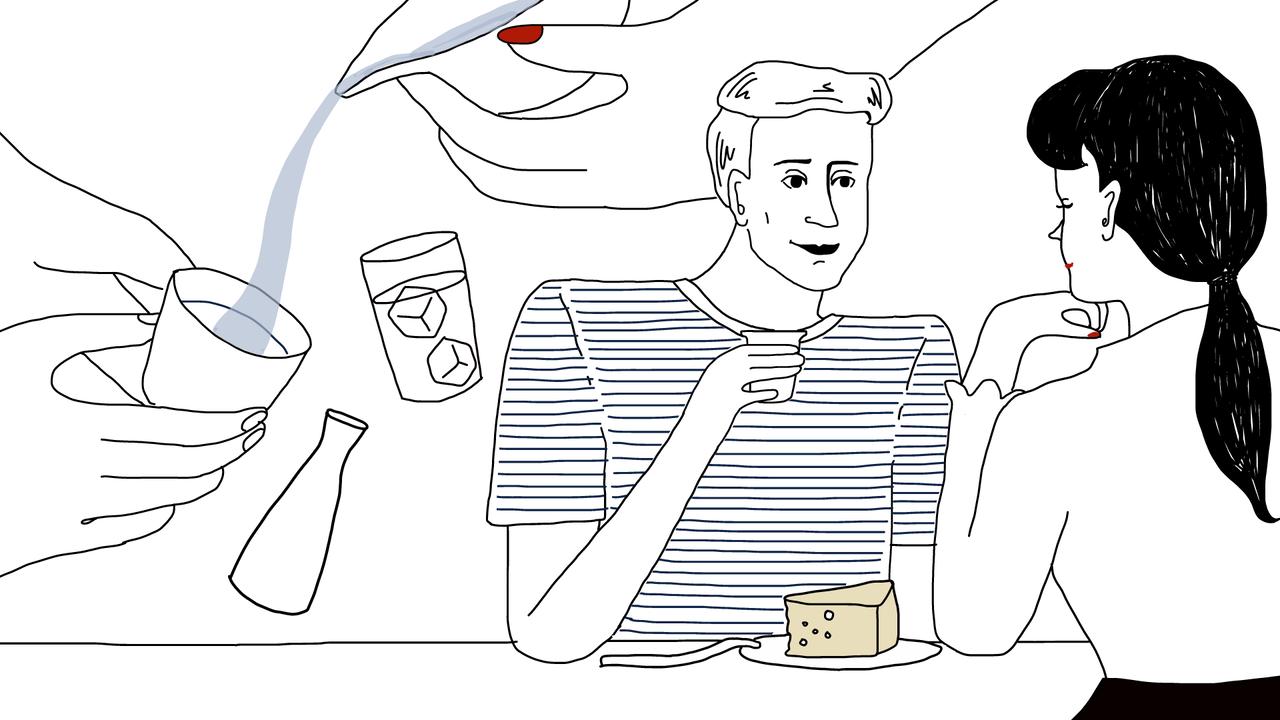
Know Your “Nihonshu”: Sake Wisdom for Guilt-Free Drinking
Guideto Japan
Culture- English
- 日本語
- 简体字
- 繁體字
- Français
- Español
- العربية
- Русский
It’s the Snacks, not the Sake
JOE Kaori, thanks so much for that junmai-shu you got me. It was really good. I have to say, though, I’m thinking of cutting back on sake because I want to watch my weight. I’ve heard that nihonshu is fattening.
KAORI The idea that sake is any more fattening than other alcoholic drinks is a myth. Basically, the calories in alcoholic beverages come from the alcohol. One gram of alcohol is 7 calories. How many calories you consume depends on the beverage’s alcoholic content and the amount that you drink. Most beer is about 5 percent alcohol. Nihonshu averages around 15 percent, whisky around 43 percent. On average, 100 grams of beer has about 35 calories, while 100 grams of sake has 105 calories, and 100 grams of whisky has 300. So, gram for gram, sake and whisky have more calories than beer, but you don’t drink sake or whisky in the same quantities as you do beer. The less you drink, the fewer calories. On the other hand, any alcoholic beverage is fattening if you drink too much of it.
JOE But nihonshu has a certain sweetness to it. Doesn’t that mean it has sugar content as well?
KAORI It’s true that fermented beverages like sake and wine have some carbohydrates left after fermentation, but it’s a very small amount—not enough to make a substantial difference in the calorie count.
JOE That’s good to know. Still . . . whenever I drink sake, I get the urge to snack, and I end up eating too much.
KAORI But that’s what drinking does in general. The alcohol gets your blood circulating and your digestive juices flowing and stimulates your appetite. And that’s okay, because drinking on an empty stomach isn’t really good for your system. But if you’re watching your weight, your best course is to steer clear of fatty junk foods and focus on quality protein, like tofu, chicken breast, cheese . . .
JOE Cheese with sake?! Don’t they clash?
KAORI It might sound a little weird, but they’re both fermented foods, and they go quite well together. And don’t forget your vegetables!
Sip, Don’t Guzzle!
JOE A friend of mine had a bad experience with chilled sake. He got drunk and started feeling sick.
KAORI Chilled sake can go down very easily. The kind of sake that’s served cold is usually slightly sweet and quite smooth. My guess is that your friend just drank too much.
JOE Apparently. He went to a wine bar, where they served this delicious, fragrant ginjō-shu in wine glasses, and it seems she downed quite a few.
KAORI It’s easy to overdo it with chilled sake. A doctor explained to me that alcohol is more quickly absorbed into the bloodstream when it’s close to body temperature. So, if you drink your sake nuru-kan, warmed to just about body temperature, you can feel the effects as you drink, and it’s easier to gauge when you’ve had enough. On the other hand, with cold sake, you can easily drink too much before you feel the effect. Then it catches up with you. If you’re worried about drinking too much, I recommend warm sake.
Water Makes Everything Better
KAORI Regardless of the temperature of your sake, it’s always a good idea to have a glass of water as a chaser. I always follow each cup of sake with a glass of yawaragi-mizu.
JOE Yawaragi-mizu? Is that some special kind of water?
KAORI No, it can be any kind of water. Yawaragi-mizu ["calming water"] is the name the Japan Sake and Shōchū Makers Association has given to water chasers, which they recommend when drinking sake. It dilutes the alcohol in your stomach, so you don’t absorb too much too fast, and it also refreshes your palate. In my experience, it slows you down some, so you don’t just keep drinking, even though you’ve had enough. Some bars even serve shikomi-mizu [brewing water], taken from the same source that the brewers use when making their sake.
JOE Shikomi-mizu! I’d like to try to that!
KAORI The mineral content of the shikomi-mizu naturally influences the flavor of the sake, so it’s interesting to compare how the two taste.
But the most important advice I can offer you when it comes to nihonshu or any alcohol is to drink in moderation. That’s the best way to avoid a hangover or other unpleasantness.
JOE Roger that!
(Originally published in Japanese. Banner and illustration by moeko)
・“Nihonshu” Now : Behind the Global Sake Renaissance
・Know Your “Nihonshu”: Understanding Sake Brewing
・Know Your “Nihonshu”: Types of Sake and Their Characteristics
・Know Your “Nihonshu”: Sake Tasting Demystified
・Yamagata and the Sake Renaissance
・Know Your “Nihonshu”: Sake Wisdom for Guilt-Free Drinking
